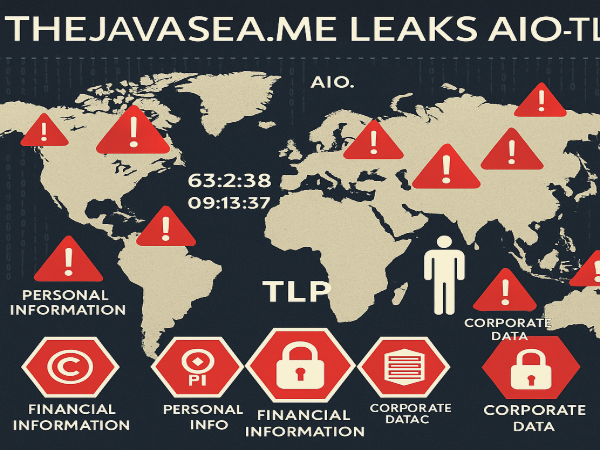Thejavasea.me Leaks AIO-TLP: Uncovering the Largest Cybersecurity Threat of the Era
Understanding the Depth and Implications of the Thejavasea.me Data Breach

Thejavasea.me Leaks AIO-TLP have emerged as one of the most alarming cybersecurity incidents in recent years, exposing vast amounts of sensitive information across multiple sectors. This breach demonstrates the growing sophistication of cybercriminal operations and underscores the urgent need for individuals and organizations to fortify their digital defenses. From personal identification details to corporate financial records, the leaked data poses critical risks, making it essential to understand the full scope of the incident and adopt proactive security measures.
What Are Thejavasea.me Leaks AIO-TLP?
The term “Thejavasea.me Leaks AIO-TLP” refers to a massive data breach where sensitive information was illicitly accessed and publicly exposed. The leaks are categorized under the All-In-One Threat Level Protocol (AIO-TLP), which classifies information based on its sensitivity and potential impact if compromised. This system uses a color-coded framework to indicate risk levels, ranging from publicly shareable data to highly sensitive information that could cause severe damage if leaked. In this case, much of the data exposed falls under the highest threat levels, affecting both individual users and large organizations.
The AIO-TLP framework serves as a benchmark for understanding the gravity of leaks like these. The protocol classifies information into four main categories: white, green, amber, and red. White is considered publicly accessible, green is for internal sharing, amber contains sensitive organizational information, and red represents the most critical data. Thejavasea.me leaks primarily involved amber and red-level data, highlighting the enormous security risks associated with this incident.
The Scope of the Breach
Thejavasea.me leaks AIO-TLP encompassed a broad spectrum of information, including:
Personal Data: Names, addresses, identification documents, and personal email accounts.
Corporate Credentials: Usernames, passwords, and access keys from various organizations.
Financial Records: Bank account information, financial statements, and internal budgeting spreadsheets.
Internal Communications: Emails, memos, and confidential corporate strategies.
The diversity of the leaked information illustrates the sheer scale of the breach and the potential consequences for both individuals and organizations. Criminals can exploit this data for identity theft, financial fraud, and corporate espionage, making the breach not only a cybersecurity concern but also a broader socio-economic threat.
How the Breach Happened
Cybersecurity experts believe the Thejavasea.me leaks occurred due to a combination of weak security protocols and targeted attacks. Some common factors contributing to such breaches include:
Phishing Attacks: Deceptive emails tricking employees into providing login credentials.
Exploitation of Reused Passwords: Attackers leveraged previously leaked passwords to gain access.
System Vulnerabilities: Outdated software or unpatched systems that allowed unauthorized access.
Insider Threats: Employees or contractors who unintentionally or intentionally exposed sensitive data.
The breach demonstrates how both technical vulnerabilities and human errors can lead to catastrophic data leaks. It highlights the importance of a comprehensive cybersecurity strategy that includes technological defenses, employee education, and proactive monitoring.
Implications for Individuals
For individuals, the consequences of the Thejavasea.me leaks AIO-TLP can be severe:
Identity Theft: Exposure of personal information increases the likelihood of fraudulent activities.
Financial Loss: Leaked banking details can lead to unauthorized transactions and financial theft.
Privacy Violations: Personal emails and identification documents can be exploited, causing emotional and social distress.
Phishing and Scams: Criminals can use leaked data to craft highly convincing phishing attacks targeting victims.
Individuals must be vigilant and take immediate action if their data may have been exposed, such as changing passwords, monitoring financial accounts, and enabling advanced security measures.
Implications for Organizations
The impact of the leaks on organizations is equally, if not more, concerning:
Reputational Damage: Companies risk losing client trust and market credibility.
Financial Loss: Legal liabilities and regulatory fines can result from the exposure of sensitive corporate information.
Operational Disruption: Breached systems may require extensive downtime for investigation and remediation.
Cybercrime Targeting: Leaked internal documents provide cybercriminals with information that can be used for ransomware attacks or competitive sabotage.
Organizations must strengthen cybersecurity measures, conduct regular security audits, and implement incident response plans to mitigate such risks effectively.
Preventive Measures Against Data Leaks
Mitigating the risks associated with large-scale leaks like the Thejavasea.me incident requires proactive strategies:
Strong Password Policies: Encourage the use of complex, unique passwords for every account.
Two-Factor Authentication (2FA): Adds an extra layer of security beyond simple passwords.
Regular System Updates: Patch software vulnerabilities promptly to prevent exploitation.
Employee Training: Educate staff on phishing, social engineering, and secure data practices.
Data Encryption: Encrypt sensitive information to protect it even if accessed by unauthorized users.
Monitoring and Alerts: Use cybersecurity tools to detect suspicious activities in real-time.
Implementing these measures reduces the likelihood of future breaches and helps organizations maintain trust and security.
Legal and Ethical Considerations
The unauthorized exposure of sensitive data brings forward both legal and ethical challenges:
Legal Consequences: Organizations may face lawsuits, fines, and regulatory penalties if they fail to protect sensitive information.
Ethical Responsibility: Companies and platforms hosting leaked data have a moral obligation to prevent misuse and protect individual privacy.
Public Interest vs Privacy: While some argue that certain leaks inform the public, it often infringes on the rights of individuals and organizations.
Understanding these dimensions is essential for developing robust policies and fostering a culture of accountability in the digital age.
The Future of Cybersecurity in the Wake of Leaks
The Thejavasea.me leaks AIO-TLP serve as a wake-up call for the cybersecurity community. Future strategies must incorporate:
Advanced Threat Detection: Leveraging AI and machine learning to identify unusual patterns.
Proactive Risk Management: Continuously assessing and mitigating vulnerabilities.
Cross-Industry Collaboration: Sharing threat intelligence among organizations to prevent similar breaches.
Public Awareness Campaigns: Educating individuals about digital hygiene and security best practices.
These steps are critical to building a resilient digital ecosystem capable of withstanding increasingly sophisticated cyber threats.
Conclusion
The Thejavasea.me leaks AIO-TLP highlight the escalating sophistication and danger of modern data breaches. The exposure of sensitive information, spanning personal, financial, and corporate domains, poses a severe threat to both individuals and organizations. By understanding the scope of the breach, its implications, and the preventive measures necessary, stakeholders can better protect themselves in an environment where cyber threats are becoming ever more complex and pervasive. Vigilance, education, and technology together form the cornerstone of robust cybersecurity defense.



